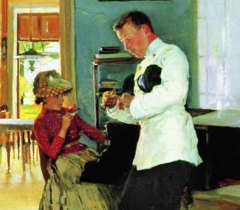
Autumn has many passports. And each one prescribes its own timing, rhythms, and actions.
One says, “From September 1st to November 30th”—a calendar. Another: “From the autumnal equinox to the winter solstice”—astronomy. There's also a climatic autumn—the one that arrives when the average daily temperature drops below certain thresholds. And then there's the “living” autumn—the phenological one, visible to the eye and nose: the first spider webs, mushroom forays, the scent of wet leaves, late berries in the wind.
If you boil it all down into one spread, you get not just a season, but a complete system: how the Earth tilts its axis, how the air holds moisture, how trees decide when to remove their green “panels” and switch to economy mode, how people reconfigure their internal clocks and daily life.
Let's break down autumn into its many layers—from space to the kitchen—and understand why it's different every year, even though technically everything is the same: the same dates, the same leaves, the same fog. The difference lies in the combinations.
Autumn Calendar: A Convenient Ruler
The calendar version is simple: September 1st – November 30th. It's convenient for schedules, statistics, studies, and culture. With this division, autumn begins on the same day—even if it's 27°C outside and smells like watermelon.
Administrative tools: schools are opening, markets are being reorganized to stock the harvest, the city is turning on soft lighting and preparing streetlights.
It's helpful to remember: the calendar is a framework, not the weather. It's needed so we can speak the same language when discussing tasks, vacations, and deadlines.
Astronomical Autumn: Axis Tilt and Light
It begins on the autumnal equinox (usually September 22-23). Astronomical autumn ends with the winter solstice (around December 21-22), when the days begin to lengthen.
This is how the famous “golden” picture is born: rays pass by, volumes appear, colors thicken.
Practical implications: autumn light is calming. For photographers, it's ideal hours; for urban workers, it's a short window of effectiveness; for drivers, it's the low, glaring sun in the morning and evening (protect your vision and windshield).
Climate Autumn: When the Temperature Says “It's Time”
Climatologists consider the beginning of autumn to be a stable transition of the average daily temperature downwards through conventional thresholds.
In temperate latitudes, the benchmarks are as follows: first, the average daily temperature drops below 15°C (the end of the “velvet” period), then below 10°C (the start of the heating season, fog), and later below 5°C (frost, persistent dampness). Each region has its own dates and rate of decline, so the climatic autumn varies across the calendar.
The point: the scale is needed by farmers, utility workers, and construction workers. It's used to plan the harvest of late crops, the mothballing of construction sites, the startup of boiler plants, and the tree pruning schedule.
Phenological autumn: the season that is visible
Phenology is the observation of natural “events.” Here, autumn is divided into stages, each recognizable.
Phenological language is useful to anyone working “on the ground”: it tells us more accurately than any date that the environment has already switched.
Why Trees Shed Leaves: Biology Without the Romance
A leaf is a sugar factory. But it's expensive to maintain: it loses water and is vulnerable to frost. When days shorten and temperatures drop, trees sever the vascular bundles between the branch and the leaf, returning nutrients from the leaf to the root, forming a corky layer in the petiole—and the leaf is “cut off.”
Green chlorophyll breaks down first, leaving behind carotenoids (yellow-orange) and anthocyanins (red and purple, “activated” on cold, clear days). Leaf fall isn't a sadness, but a saving: reducing the surface area for evaporation, waiting out the wind and frost, without losing the “cash.”
A side effect is beauty. A beneficial side effect is humus for the soil in spring: the leaves are future food for the forest.
Air, fog, inversions: the physics of the season
In autumn, calm and clear nights are common: the ground cools, and the surface layer cools more than the surface layer, resulting in an inversion. In an inversion, sound travels further, fog settles in low-lying areas, and odors linger near the ground. In the morning, the sun warms a thin layer, and the fog dissipates, but in light winds, it can linger until midday.
Another key factor is supercooled raindrops at subzero temperatures: they freeze on branches and wires, creating frost and ice. Therefore, the combination of “fog and subzero temperatures” is a warning sign: vertical surfaces become coated with ice, and paths become glassy.
Autumn and Man: Internal Clock and Everyday Life
Shorter days change our routine. More melatonin means it's easier to fall asleep, and harder to stay awake without light; cortisol levels even out; and appetite craves hearty, warm foods.
It's not the “autumn blues,” but adaptation. Simple things help: morning light (getting outside in the early hours), breaking the day into short tasks, and eating warm food as a ritual rather than a snack. The autumn rhythm calls for shorter plans and deeper focus.
In everyday life, autumn is the season for “checks”: window seals, gutters, tires, shoes with good soles, a supply of salt and sand at the entrance. It's all prosaic, but it's precisely this feature that distinguishes a comfortable autumn from a lottery.
Seasonal Economy: Heat, Water, Light
Autumn brings heating—the city's biggest expense—to life. How a house retains heat is crucial: snow will help later, but first, it's the windows, door frames, and seams that work.
The water in rivers and reservoirs loses heat, fog over the water intensifies, and in late autumn, “steam” effects occur during frost.
Electricity is wasted on lighting: short days require well-thought-out “light hygiene”: warm lamps in the evening, cool light during the day in work areas, so as not to confuse the brain.
Culture and rituals, autumn holidays
Autumn is the time for results and agreements.
Hence the rural autumn festivals:
- Autumn (renewal of fire, new harvest bread);
- Pokrov (start of the “home year”);
- Matchmaking, (“true” dreams);
- Fairs (exchange of surplus goods, replenishment of stocks);
- The first gatherings by the stove (crafts, songs, “social glue”).
These practices are not sweet traditions, but risk management tools: to unite people, distribute resources, and confirm mutual assistance before a long cycle.
Autumn “by science” and “by feelings”
On the one hand, there is data:
- equinox dates;
- temperature chart;
- precipitation;
- length of the day.
On the other hand, there are signs: the smell of wet bark, the first cranes in the sky, whitish frost, the heavy air of the courtyards.
Autumn is at its most “harmonious” when we use both languages.
Example: the forecast says “+1 at night, foggy,” the nose says “high humidity,” the eyes see “frost on the grass in the morning” – this means it will be slippery in the evening and it's time to change to rough shoes.
Or vice versa: the climatic autumn has not yet arrived, but the phenological one has already begun – we are picking mushrooms, drying herbs, preparing vitamins.
Why is autumn different every year?
Because anomalies combine: cyclonic activity, ocean temperatures, long-range air transport, localized droughts, or excessive summer rainfall. One year, there's a luxuriously dry “golden mean,” while another sees continuous rain and sudden leaf fall. Yet the seasonal structure remains: light falls lower, the air holds moisture longer, and living systems fold up, only to unfold later.
Autumn isn't just “between summer and winter.” It's the time of year when the work of many mechanisms synchronizes in one direction: reduce consumption, preserve the core, prepare for spring. The calendar gives us convenient dates, astronomy provides light logic, climate provides real dates, and phenology provides living reference points. Humans add organization: fire, bread, order, agreements.
If we put it all together in one formula, it turns out that autumn is the season of meaningful savings:
- the light comes more accurately;
- the air moves slower;
- plants turn off their decorative functions and return resources to the root;
- We shift the emphasis from endless “meetings with the world” to the arrangement of the home and internal rhythm.
Autumn ceases to be a sad “loss of summer.” It becomes a workshop where tools are sharpened and the plan for the next growth is “weaved.”
Try experiencing it in two modes at once: by data (light, temperature, forecast) and by signs (smells, leaves, birds). Then you'll see not just “weather,” but the season as a contract—with the land and the house.





